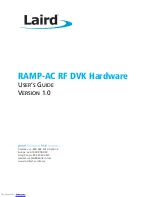
Ramp-AC RF DVK Hardware
Version 1.0
Americas: +1-800-492-2320 Option 2
Europe: +44-1628-858-940
Hong Kong: +852-2923-0610
[email protected]
www.lairdtech.com/ramp
9
CONN-GUIDE-RAMP-AC-DVK-HW
J1 Pin
#
Type AC5124
Pin #
AC5124
Signal
Name
AC1524
AC3124
AC4424
AC4490
AC4486
AC4868
Pin #
AC1524
AC3124
Signal Name
AC4424
Signal Name
AC4490
AC4486
Signal
Name
AC4790
Signal
Name
AC4868
Signal
Name
40
GND
40
GND
16
GND
GND
GND
GND
GND
I – Input to the transceiver
O – Output from the transceiver
NC – No Connection (though there is an internal connection in some instances, therefore, this pin should be left
disconnected)
Note: The 40 pin header (J1) on the SDK board maps directly (pin-for-pin) to the 40 pin connector (J3).
Interfacing the AC DVK to RS232 Hardware
The DVK serial board is defined as a DCE (Data Communications Equipment). DCE is wired to interface
directly with DTE (Data Terminal Equipment). Typically, DTE is defined as a PC and DCE is defined as a
peripheral. To interface DCE to other DCE or DTE to other DTE, a null modem is required. The null modem
swaps pins to convert a DCE to a DTE and vice-versa. Normally, a null modem consists of a female and a male
DB9 connector. A typical null modem configuration is shown below.
Table 6: DTE, DCE and Null Modem Signal Definitions
DCE
Pin #
DCE Signal
Name
DCE
Direction
DTE
Pin #
DTE Signal
Name
DTE
Direction
Null Modem
Female DB9
Null Modem
Male DB9
1
DCD
O
1
DCD
I
1
4 or NC
2
TXD
O
2
RXD
I
2
3
3
RXD
I
3
TXD
O
3
2
4
DTR
I
4
DTR
O
4
6 and 1 or NC
5
GND
5
GND
5
5
6
DSR
O
6
DSR
I
6
4 or NC
7
RTS
I
7
RTS
O
7
8
8
CTS
O
8
CTS
I
8
7
9
RI
O
9
RI
I
9
NC
Interfacing the AC DVK to RS485 Hardware
The SDK serial board has been designed to interface to RS-485 equipment. If such operation is desired, the
COMM Select jumper should be set to RS485 Enable. The RS-485 circuitry used by the SDK board has been
specially designed to negate the requirement for a DE/RE signal. Thus, the receiver is always enabled unless
the transceiver has something to send to the OEM host. The OEM must ensure that the OEM host does not
send data at the same time as the transceiver; otherwise a RS-485 contention occurs because the RS-485
hardware is half duplex.
Table 7: RS-485 Header Pins
RS-485 Pin Name Description
A TRUE
The non-inverted form of the serial data. This pin is at rest high.
B INVERT
The inverted form of the serial data (exact inversion of A TRUE). This pin is at rest low.
GND
GND
Downloaded from
Downloaded from
Downloaded from
Downloaded from
Downloaded from
Downloaded from
Downloaded from
Downloaded from
Downloaded from










